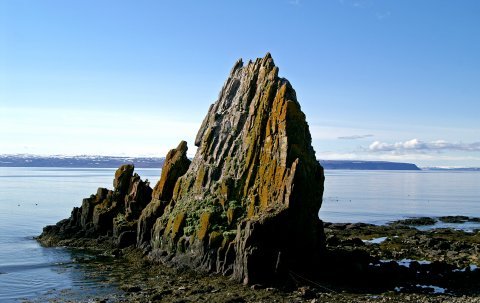Ánastaðir - How a whale beaching saved the people

Did you know that the whale beaching at Ánastaðir in 1882, saved many people from starvation?
Listen to a story from Sólveig Benjamínsdóttir, the director of museums in the municipality Húnaþing vestra.
In the player below you can listen to the story as well as it is available in writing further down the page.
The story is read by Birna Pétursdóttir.
"My name is Sólveig H. Benjamínsdóttir and I’m the director of museums in the municipality Húnaþing vestra. The following text is the retelling of a story, originally told by Guðmundur Jónsson from Ánastaðir in 1939.
The story of the whale beaching at Ánastaðir, which occurred on 25 May 1882, begins, in fact, two days earlier. That day, a crazy snowstorm was raging in every region with sea ice all around the country. The storm blew the sea ice closer to land so that it filled all fjords. On May 25, when the weather finally began calming down, Eggert Jónsson, the farmer at Ánastaðir, noticed dozens of whales in a cove south of the farm. The whales were trapped by the ice which had drifted to the shore the days before. Eggert realised that this was an ideal setting for killing the whales and went down to the cove where they were trapped. He had himself tied to land by rope in case he would fall into the sea and walked out onto the sea ice. He used a machete to cut through the whales’ fat layer, making sure to position the cut right above their hearts so that killing them would be easy. Yet the whales took such an intense jolt of pain that Eggert almost lost his balance on the slippery surface and fell into the water. However, the whales died quickly and sank. After the slaughtering was finished, the farmers had to wait for a few days for gas to form in the whales’ intestines so that they would become bloated and resurface. Then the cutting began. The pieces of whale meat saved many people from starvation the following winter.
As the whale beaching had occurred on the land of Ánastaðir, of which Eggert Jónsson was the majority owner, the largest part of the whale meat belonged to him. When people showed up for the cutting, he decided that each person could claim half of the meat on the whale that they cut. This was unusually generous of him, because habitually, the cutters only got a fourth or a third share. However, Eggert believed the whale beaching to be a gift from God and that it was his responsibility to share the meat with as many households as possible during the ongoing times of hardship. Every single home in Húnavatnssýsla county received a portion of the whale meat. Part of the meat was also delivered to the surrounding regions: Skagafjörður, northern Borgarfjarðar- and Mýrarsýsla, Dalasýsla and the Strandir region in the north. Eggert had an entire whale sent to Saurbæjarhreppur district in Dalasýsla, which was in the worst position for coping during the hunger period.
Eggert’s generosity was invaluable because even harder times were to come. In the summer following the beaching, the weather was cold with a constant wind from the north. Until mid-summer, most nights were frosty with snowfall. Farming was difficult under such circumstances; the farmers had no hay and many sheep died. At a number of farms, no lamb survived, and adult sheep died, too. The situation worsened still because no freight ship arrived in Húnaflói bay that autumn, as was customary. Necessities were therefore unavailable and famine was imminent. The only food people had that autumn were dairy products and the good whale meat from Ánastaðir. The great whale beaching saved people from many districts from starvation during these difficult times."